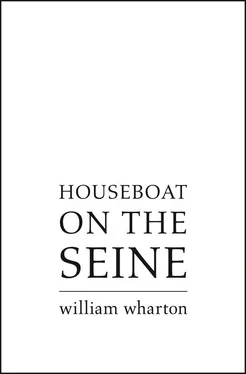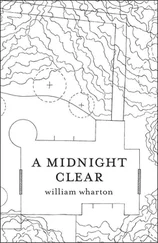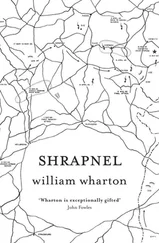WILLIAM WHARTON
Houseboat on the Seine
To the river we love and all who live on it.
‘Love this river, stay by it, learn from it.’ Yes, he wanted to learn from it, he wanted to listen to it. It seemed to him that whoever understood this river and its secrets, would understand much more, many secrets, all secrets.
— Hermann Hesse
Siddhartha
Table of Contents
Title Page WILLIAM WHARTON Houseboat on the Seine
Dedication To the river we love and all who live on it.
Epigraph ‘Love this river, stay by it, learn from it.’ Yes, he wanted to learn from it, he wanted to listen to it. It seemed to him that whoever understood this river and its secrets, would understand much more, many secrets, all secrets. — Hermann Hesse Siddhartha
1 Kindergarten Entrapment
2 A Brief Enchantment
3 The Cutting Edge
4 In the Hands of the Gods
5 Getting Up in the World – and Down
6 White as Driven Snow
7 The Floor Plan
8 Smoothing Things Out
9 Money Problems
10 Time Passes and Then the Gangplank
11 Family Arrangements
12 Moving In!
13 Digging Out
14 Two Holes in One
15 Dead Man Tales
16 10-Meter I-Beams
17 The Rug Merchants, Part I
18 A Wonderful Surprise
19 Bringing It Together
20 Blood in the Street
21 Impatience
22 Finale, I Hope
Also by William Wharton
Copyright
About the Publisher
1
Kindergarten Entrapment
My wife, Rosemary, was for twenty-five years a kindergarten teacher at the American School of Paris. Last year, by French law, she was forced to retire. I must say, almost everything I’ve ever really needed to know, I learned from my kindergarten-teaching wife, except somehow, she never taught me how to live on a houseboat.
About twenty-five years ago, she worked with a lovely woman named Pauline Lee. Pauline taught first grade next to Rosemary, and lived on the Seine in a houseboat. The houseboat was located in the small village of Le Port Marly, not far from Versailles and St Germain-en-Laye, ten miles west of Paris proper.
One day, Pauline suggested that the kindergarten and the first grade go out on a field trip to visit her houseboat.
My wife was enchanted with what she saw. I don’t really know if the kindergarten children were – that’s not my concern. My main concern is my wife, and she’s something to be concerned about. Anyway, she came home all excited and wanting to live on a houseboat. That sounded crazy enough, but was OK with me. Rosemary is subject to these impulsive, out-of-this-world decisions, and I’ve learned to go along for the ride.
‘Just tell Pauline to keep an eye out in case there are any cheap boats available, dear.’
I’d had a few good painting sales for a change, and was feeling relatively flush. Oh, how easily one can dive in over one’s head … literally! My problem was I didn’t actually believe any of this was for real.
Three weeks later, Pauline calls to tell us a houseboat only four boats toward Paris from theirs had burned to the waterline over New Year’s Eve, and she thought it might be for sale. We contact the owners, and sure enough it is. And I might say, for good reason , more good reasons than I could possibly realize.
That weekend, we drive out to look at this boat. It’s a beautiful day, and I’m thinking that maybe we can take a nice walk in the forest at St-Germain-en-Laye. We stop by Pauline’s, and she points out the boat that’s for sale.
We thought we would be having Pauline as a neighbor, but it didn’t work out that way. Bob, her husband, had been very much involved with the students during what the French call ‘Les Événements de Mai’, that is the Student Revolution. When all the smoke died down, Bob was asked to leave by the administration of the school where he worked, The American College of Paris. He not only left the job, but he and his wife left the country as well. They went back to Michigan, where Pauline is again teaching.
We look over the quay down a muddy hill to the water. This is a flat-bottomed wooden boat, sixteen feet wide by fifty-four feet long. It’s actually more like a house than a boat. It has no real bow or stern. It’s just rectangular and flat. There’s no motor, no sails. It has wood siding with windows, the kind you might find in any ordinary house. It even has shutters on the windows. I’m thinking, where are the portholes? Pauline explains this boat had been built on an old sand barge by a French Arctic explorer named Victor Émile, sort of a French version of Admiral Peary, for his lady friend. That sounds romantic enough, but this boat isn’t very romantic now.
Pauline has the key, so we walk down the squishy quay on stone steps, then up a small gangplank and into the boat. It’s completely smoke-damaged, the ceiling’s burned out with bare electrical wires hanging everywhere, and most shockingly impressive … truly burned down to the water on the river side. The water laps into the boat when scullers swish by. These turn out to be the main traffic on this dead arm of the Seine where the boat is located. There are about a dozen or so houseboats in this area, protected by an island in the center of the river. The advantage is the houseboats do not bounce with the backwash of each huge barge as it hauls cargo from Le Havre to Paris and back.
Pauline explains all this with verve and enthusiasm. I just want to hop back in our car and go for a walk in the forest. But our children are as enchanted as my wife. Now, this would be exciting living, not the way it is in dirty old Paris. Can you believe it? I swear, this damned boat is bewitching, or maybe our children are getting too blase!
‘Smell the air, Dad, how great it would be to live out here after all the pollution in Paris.’
I sniff. It smells like an open sewer to me. This was over twenty-five years ago, and at that time, the Seine was virtually an open sewer. Paris and all the villages along the river down from Paris, in a beautiful, long, meandering curve, were dumping raw sewage directly into the river. Naturally, this boat is down river from Paris!
To make everybody, that is, wife and kids, happy, I put in a ridiculous, insulting bid for this crippled wooden hulk. We go for our walk, and I’m ready to forget about the whole thing.
A week later, I’m shocked when my bid is accepted. Accept is mild – they jump at it. Yet, little as I bid, I must borrow money to swing this cockeyed, insane deal. Painters are rarely rich, or even reasonably comfortable. I often challenge friends to name fifty American painters making a regular living painting – not teaching, or working in TV or films, or in advertising – just painting pictures and selling them. Sometimes, there will be a flurry for a particular painter, but it rarely lasts more than a few years, then it’s back to the old easel and bean soup, especially if a painter happens to have a family. No one has ever come up with more than twenty who are truly making it. But it is a great life. So it goes.
For the next three months, my painting is suspended in the interest of romance, excitement, adventure, WITCHCRAFT – such an important change for a man who lives in the streets or out in fields and likes it. I’m feeling caught up in something wicked. I am! I’m not a river man. The Seine, for me, is something to paint. It is constantly moving, changing, at the same time it is still, like a good model.
Our lives up to this point have been something of a dream. I was an art teacher in the Los Angeles City Schools until 1960. Then, since I saw myself as an artist, not a teacher, we came to Europe. One of the main reasons was to keep our children away from American television. Also, at that time, living was cheaper here.
Читать дальше












